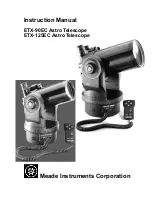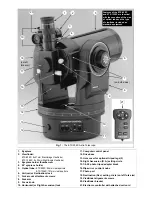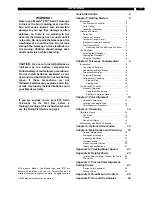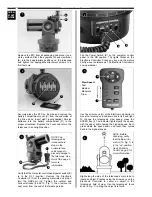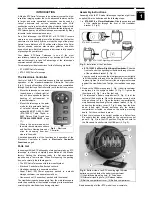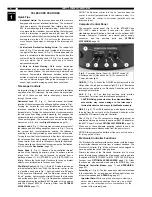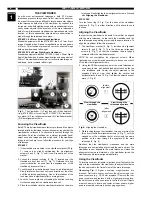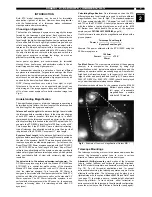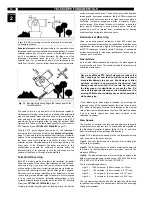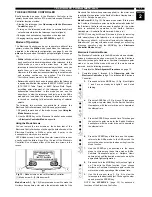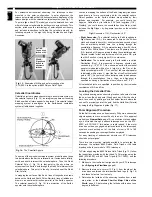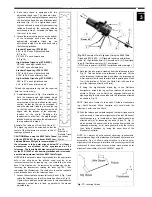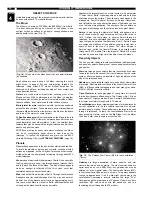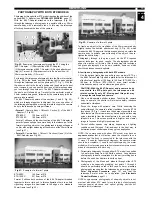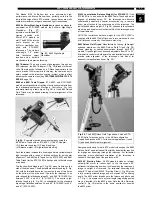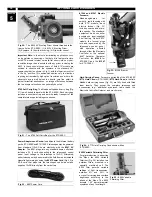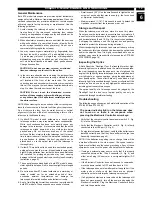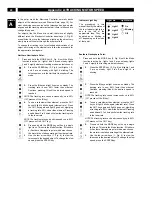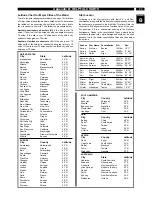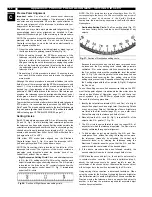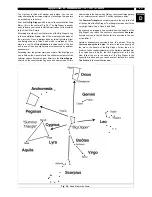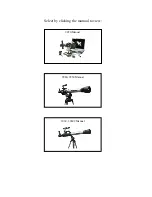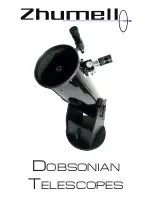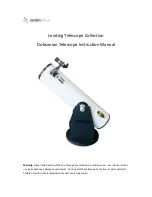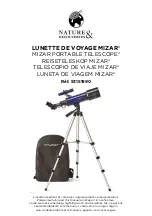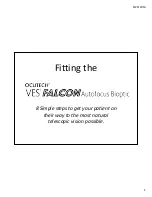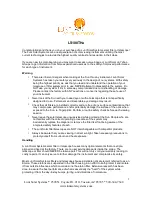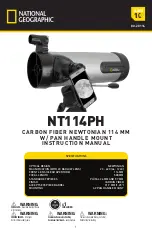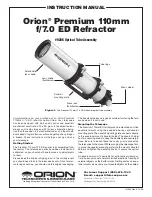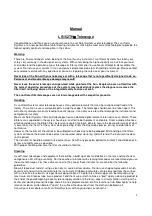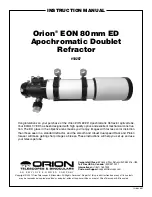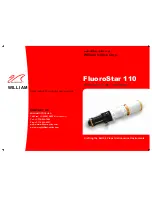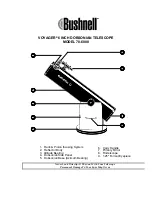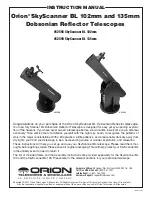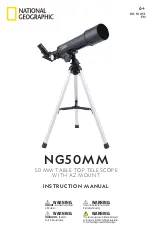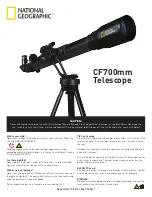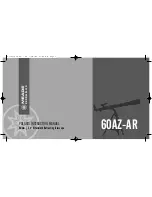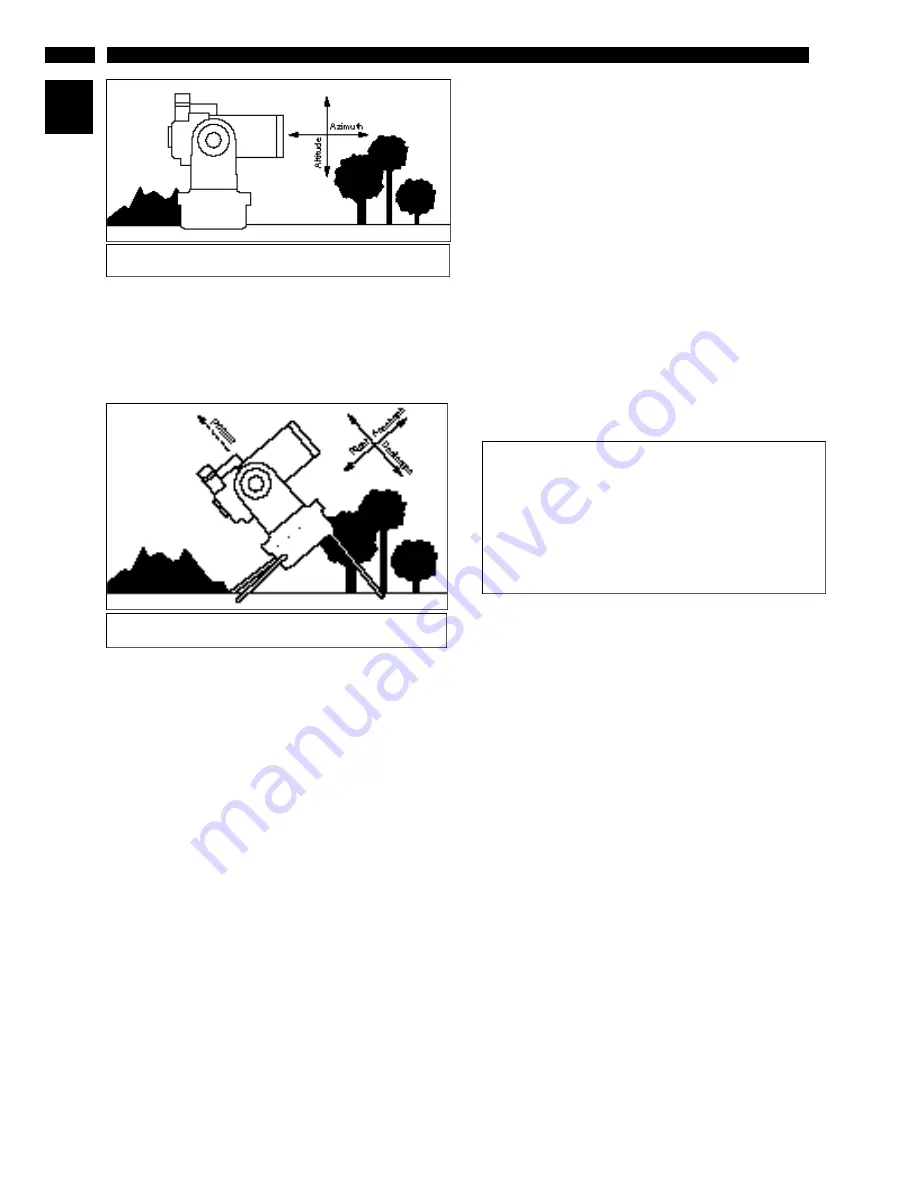
CHAPTER
2
z
10
TELESCOPE FUNDAMENTALS
Equatorial mounts are highly desirable in the operation of any
telescope used for extensive astronomical applications, because
celestial objects do not move in vertical or horizontal directions
but in a combination of these directions. By tilting one of the
telescope’s mechanical axes (see Fig. 11) to point at the
celestial pole (i.e., by pointing one axis of the telescope to the
North Star, Polaris), you may follow (track) astronomical objects.
You need to turn in only one axis of the telescope instead of
simultaneously turning in two axes, as required of the altazimuth
mount. An equatorial mount which has one of its axes (the polar
axis) pointing to the celestial pole is polar aligned. Both ETX
models can be polar aligned either by using the optional #883
Deluxe Field Tripod or the table tripod specific to your model of
ETX telescope (see OPTIONAL ACCESSORIES, page 17).
With the ETX polar aligned (see page 12) the telescope’s
internal motor drive may be activated (see Modes of Operation,
page 11) to enable fully automatic hands off tracking of celestial
objects. In this configuration the observer does not need to press
the arrow keys of the Electronic Controller in order to track
celestial objects. Notwithstanding this automatic tracking, the
arrow keys of the Electronic Controller are useful in this
configuration to enable the centering of objects within the
telescopic field or, for example, to rove the telescope over the
surface of the Moon or through a large star field.
Terrestrial Observing
Both ETX models make excellent, high-resolution terrestrial
(land) telescopes. When you set the telescope on its drive base,
as shown in Fig. 1, you may use it for an extremely wide range
of observations. However, terrestrial images are right-side-up,
but reversed left-for-right when viewed through the eyepiece.
Normally, such an image orientation is not bothersome, unless
you are trying to read a distant sign, for example. If the telescope
is to be used for extensive terrestrial observations, a fully
correctly oriented image is provided with the #932 45° Erecting
Prism (see OPTIONAL ACCESSORIES, page 17).
Viewing terrestrial objects requires looking along the Earth's
surface through heat waves. These heat waves often degrade
image quality. Low-power eyepieces, like the SP26mm eyepiece,
magnify these heat waves less than higher-power eyepieces.
Therefore, low-power eyepieces provide a steadier, higher-
quality image. If the image is fuzzy or ill-defined, reduce to a
lower power. Observing in early morning hours, before the
ground has built up internal heat, produces better viewing
conditions than during late-afternoon hours.
Astronomical Observing
Used as an astronomical instrument, either ETX model has
many optical and electromechanical capabilities. In astronomical
applications, the extremely high level of optical performance of
both ETX telescopes is readily visible. The range of observable
astronomical objects is, with minor qualification, limited only by
the observer’s motivation.
Sidereal Rate
As the Earth rotates beneath the night sky, the stars appear to
move from East to West. The speed at which the stars move is
called the sidereal rate.
If the telescope is polar aligned (enabled by mounting the
telescope to one of the optional tripods), the motor drive in each
ETX model is designed to rotate the telescope at the sidereal
rate so that it automatically tracks the stars. This tracking makes
it easy to locate objects and keep them centered in the
telescope’s eyepiece.
Slew Speeds
The Electronic Controller has four slew speeds that are directly
proportional to the sidereal rate. These speeds are signified by
the Electronic Controller indicator lights (2, Fig. 6) and have
been calculated to accomplish specific functions.
Light 1: The fastest slew speed moves the telescope quickly
from one point in the sky to another.
Light 2: The next fastest speed is best used for centering the
object in the viewfinder.
Light 3: The third speed is set to enable centering the object in
the field of a low-to-moderate power eyepiece, such as the
standard SP26mm.
Light 4: The slowest slew speed is for centering an object in the
field of view of a high-power eyepiece (e.g., 200X to 300X for the
ETX-90EC or 400X to 500X for the ETX-125EC).
The four available speeds are:
Light 1 = 1200 x sidereal (300 arc-min/sec or 5°/sec)
Light 2 = 180 x sidereal (45 arc-min/sec or 0.75°/sec)
Light 3 =
32 x sidereal (8 arc-min/sec or 0.13°/sec)
Light 4 =
8 x sidereal (2 arc-min/sec or 0.034°/sec)
The two slowest speeds (8x and 32x sidereal) should be used
for pushbutton tracking of astronomical objects while observing
through the eyepiece.
Never use a Meade ETX Astro Telescope to look at the
Sun! Looking at or near the Sun will cause instant and
irreversible damage to your eye. Eye dama ge is often
painless, so there is no warning to the observer that
damage has occurred until it is too late. Do not point
the telescope or its viewfinder at or near the Sun. Do
not look through the telescope or its viewfinder as it is
moving.Children should always have adult supervision
while observing.
Fig. 11: Equatorial mounting aligns the telescope with the
celestial sphere.
Fig. 10: Alt/Az mounting moves the telescope in vertical and
horizontal directions.

